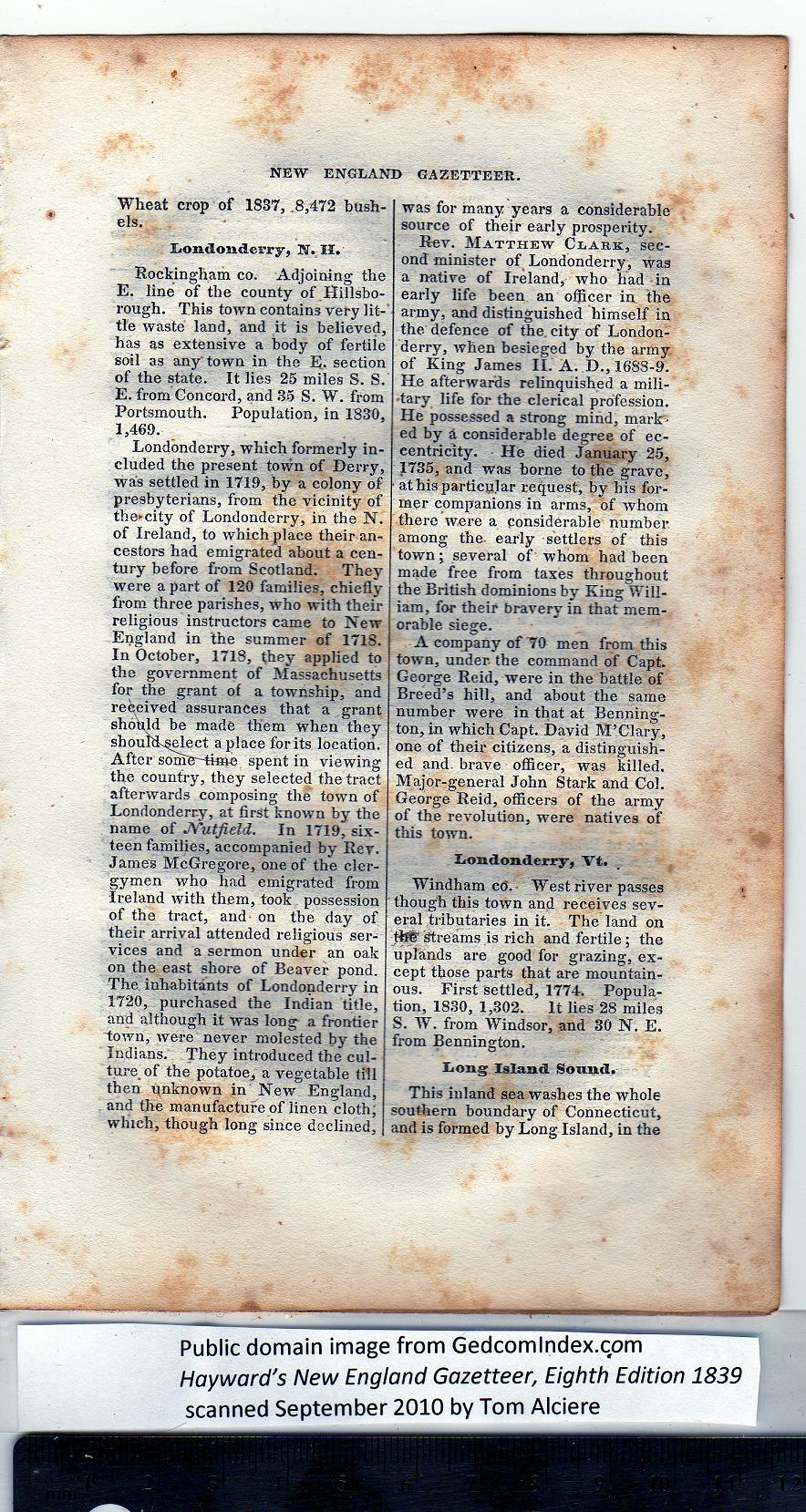|
Wheat crop of 1837, .8,472 bush-
els.
Londonderry, N. H.
Rockingliam co. Adjoining the
E. line of the county of .Hillsbo-
rough. This town contains very lit-
tle waste land, and it is believed,
has as extensive a body of fertile
soil as any'town in the E. section
of the state. It lies 25 miles S. S.
E. from Concord, and 35 S. W. from
Portsmouth. Population, in 1830,
1,469.
Londonderry, which formerly in-
cluded the present town of Derry,
was settled in 1719, by a colony of
presbyterians, from the vicinity of
the*city of Londonderry, in the N.
of Ireland, to which place their an-
cestors had emigrated about a cen-
tury before from Scotland. They
were apart of 120 families, chiefly
from three parishes, who with their
religious instructors came to New
England in the summer of 171$.
In October, 171S, they applied to
the government of Massachusetts
for the grant of a township, and
received assurances that a grant
shoirld he made them when they
sbouftL§elect a place for its location.
After some^'-time spent in viewing
the country, they selected the tract
afterwards composing the town of
Londonderry, at first known by the
name of JVutfield. In 1719, six-
teen families, accompanied by Rev.
James McGregore, one of the cler-
gymen who had emigrated from
Ireland with them, took possession
of the tract, and on tbe day of
their arrival attended religious ser-
vices and a sermon under an oak
on the east shore of Beaver pond.
The inhabitants of Londonderry in
1720, purchased the Indian title,
and although it was long a frontier
town, were never molested by the
Indians. They introduced the cul-
ture, of the potatoe, a vegetable till
then unknown in New England,
and the manufacture of linen cloth,
which, though long since declined,
was for many years a considerable
source of their early prosperity. |
Rev. Matthew Clark, sec-
ond minister of Londonderry, was
a native of Ireland, who had in
early life been an officer in the
army, and distinguished himself in
the defence of the. city of London-
derry, when besieged by the army
of King James II. A. D., 1688-9.
He afterwards relinquished a mili-
tary life for the clerical profession.
He possessed a strong mind, mark-
ed by a considerable degree of ec-
centricity. He died January 25,
1735, and was borne to the grave,
■ at his particular request, by his for-
mer companions in arms, of whom
there were a considerable number
among the. early settlers of this
town; several of whom had been
made free from taxes throughout
the British dominions by King Will-
iam, for their bravery in that mem-
orable siege.
A company of 70 men from this
town, under the command of Capt.
George Reid, were in the battle of
Breed’s hill, and about the same
number were in that at Benning-
ton, in which Capt. David M’Clary,
one of their citizens, a distinguish-
ed and- brave officer, was killed.
Major-general John Stark and Col.
George Reid, officers of the army
of the revolution, were natives of
this town.
Londonderry, Vt.
Windham co'.- West river passes
though this town and receives sev-
eral tributaries in it. The land on
Streams is rich and fertile; the
uplands are good for grazing, ex-
cept those parts that are mountain-
ous. First settled, 1774. Popula-
tion, 1830, 1,302. It lies 28 miles
S. W. from Windsor, and 30 N. E.
from Bennington.
Long Island Sound.
This inland sea washes the whole
southern boundary of Connecticut,
and is formed by Long Island, in the |
